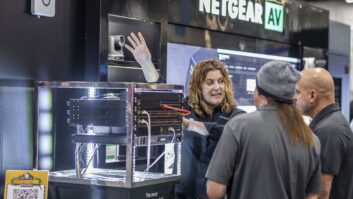
For the resi integrator looking to crossover into commercial, projects like this one at the Washington DC METRO Command Center and the Rail Operations Center (ROC) might require a higher learning curve. Eric Choucroun, AV account executive at Washington Professional Systems (WPS), was responsible for audio video integration on this large-scale project.
Facing a housing market that remains sluggish, residential electronic systems contractors have been casting their nets further, and in some cases expanding into commercial installation. While the commercial landscape may differ from residential integration on both a product and a business level, there’s also opportunity.
Fortunately for residential ESCs looking to expand, there are many manufacturers already adept at both channels that can share their commercial experience. With some forethought and preparation, they say, it’s possible for successful residential dealers to become accomplished commercial integrators, as well.

Wendy Long, vice president of marketing for Da-Lite, noted that she’s definitely seen an upswing in residential dealers moving into primarily light commercial work. “We’ve seen even more than in the past, including boardrooms, conference rooms,” she said.
Middle Atlantic residential sales associate David Horn thinks that the days of being a dedicated home theater shop are gone, and that commercial installation provides a great way to diversify a business, at least on a small scale. “I think it’s been reasonably easy for them to move in because of the similarities in things like distributed audio and video,” he explained. “I don’t see the residential guys doing stadiums or theater complexes, but they can find their feet in light commercial pretty quickly.”
Pete Baker, VP of marketing for Remote Technologies, agreed, but added a caveat: “I do think that it’s not for someone who just casually wants to wander into that business,” he said.
Jeff Kussard, director of strategic development for AV distributor Capitol, said that in the past 18 months he’s seen larger contractors with substantial residential experience going after light commercial or projects under 50,000 square feet. “In terms of inquiries from prospective new dealers, we’re looking at a 15-20 percent uptick in new contacts in the last 10-12 months,” he stated.
Understanding the Challenges
Marc Kellom, director of marketing for Harman’s JBL Synthesis, Lexicon, Revel, and Crown brands warns residential dealers that commercial audiovideo is a very different beast from what they’re used to facing. For instance, few residential installations use constant-voltage 70v loudspeakers, and commercial installations have a far greater need for weather- and theftresistant products.
“I cringe when I’m in a restaurant and I see residential speakers,” he opined. “That tells me a residential dealer did a hack job.”

On the product side, Da-Lite’s Long noted that residential products often don’t have the same functional needs as commercial installs. Sources and inputs can be substantially different, both in terms of quantity and type. Few off-the-shelf residential products use BNC connectors, for example. Beyond that, with larger or just more complex commercial installations interoperability becomes more important. “More of your equipment is going to need to be coordinated from A to B to C,” she explained.
Victor Pak, CEO of Pakedge Device & Software Inc., strongly cautions dealers against putting residential networking products into commercial jobs. He emphasizes that reliability and functionality are paramount and that doing the job the system needs to do, every time, is a commercial client’s primary consideration.
“Too many times I’ll see an integrator takes the usual IP Ethernetbased audio and video products they’ll specify for a residential installation and install them into a corporate network,” he explained. “But you have to understand, from an IP protocol standard, why such consumer products might be wrong for a commercial application.”
In addition to product differences, Andy Dixon, marketing and education specialist for Mitek Electronics, noted the technical knowledge that dealers must have to work on commercial projects. “Things like sound masking are crucial to get the sound levels to what the end user would expect,” he explained, while also pointing out that sound coverage patterns, power taps, and other technologies can be different in commercial projects.

Michael Braithwaite, senior vice president and chief technology officer for ClearOne, added that commercial public address systems also have different standards than home audio systems. “SPL may not important, but intelligibility is,” he stated. “The residential guy is good at making it loud but might not be good at making it intelligible.”
To achieve that goal, Braithwaite says that speaker placement and amp selection comes into play, and even the programming material is important. “These aspects are more serious than things like connectors,” he explained. “You can get yourself into big trouble if you don’t know how to balance a system.”
For commercial video applications, Braithwaite suggests that dealers take a look at the systems out there that are digital and do the signal, filter arrangements, and DSPs, to take some of the guesswork out of the system design. “Now whether I’m doing an airport or a sports bar, I can keep the screens all consistent,” he said. “In a multiscreen setup, everyone’s seen an unbalanced system where some TVs look great and others not so great.”

When working with control products, RTI’s Baker explained that commercial programming is less about “glitz and glamour,” and all about performance and function. “On residential projects our dealers might want to use .wav files and animation in their GUIs, whereas they’re going to want more simple and direct screens on a commercial touchpanel,” he said.
Baker also pointed to a more straightforward use of things like RS232 and two-way control. “On a commercial project it may just be status feedback to ensure that the system is functioning properly,” he said, “while in a residential project the focus is on metadata from media servers and other sources.”
From a business perspective Middle Atlantic’s Horn cautioned that residential ESCs need to be aware of how the commercial sales process differs from residential. For one thing, “there’s a lot more bidding and a lot more competition, especially these days,” he said.
Horn also emphasized the need for robust hardware in commercial projects. ESCs need to choose a product for its longevity in an environment with a far more demanding duty cycle.

More importantly, Horn suggests that both product selection and system design need to take simple operation and ease of use into consideration. “A commercial application is going to have all types of people using their system, whereas in a residential one it’s simple to train a homeowner on even a complex system.”
Horn and Long aren’t alone in their assessment that commercial is a totally different sales environment. Kussard counsels dealers that the way they couch their presentations to clients will be completely different. And beyond that, the need for documentation is unavoidable.
“Having worked as a residential contractor myself, I have an understanding of how some can get by on a wing and a prayer on documentation from design through as-built,” he said. “That whole documentation process is much more important, and the expectation from the end user is much more demanding.”
Tom Lowell, residential sales manager for Lowell Manufacturing, noted that code compliance can be a very big deal in commercial projects, and that dealers need to know what the authorities are looking for. “If there’s not a UL sticker on a box or UL labeling on a cable at inspection time, that can really hurt,” he noted.
Know Your Limits
While encouraging residential integrators to expand, Lowell president John Lowell advises them to know their limits. “There’s a fine line between taking on a big job and knowing when to defer to a more seasoned commercial dealer,” he explained, stating that depending on the requirements, a grocery store or an office building might be too much for the first-time dealer. He’s seen that in the field already, and as a vendor, Lowell has to walk a line. “Because we have dedicated reps for residential and commercial, we often have dealers fighting over the same customer.”


That’s not to say that moving into commercial is loaded with downside. With regard to crossing back and forth between residential and commercial Pak offers encouraging words for aspiring dealers, saying that if they become adept at installing commercial IP networks, the networking skills they gain will be invaluable in designing and installing networks for homes. “Home networks are becoming more complex as IP-based audio-video converges with computers, Audio Video Bridging emerges as a new connectivity standard, and the line between residential and commercial continues to blur,” he said.
The bottom-line message from most vendors is that dealers should do their homework before jumping into uncharted waters. “The little bit of start-up investment that you’ll have to make in study time will more than make up for itself in long-term client satisfaction,” Kussard concluded.
Lee Distad (www.leedistad.com) is an Edmonton, Alberta-based custom channel business consultant.



